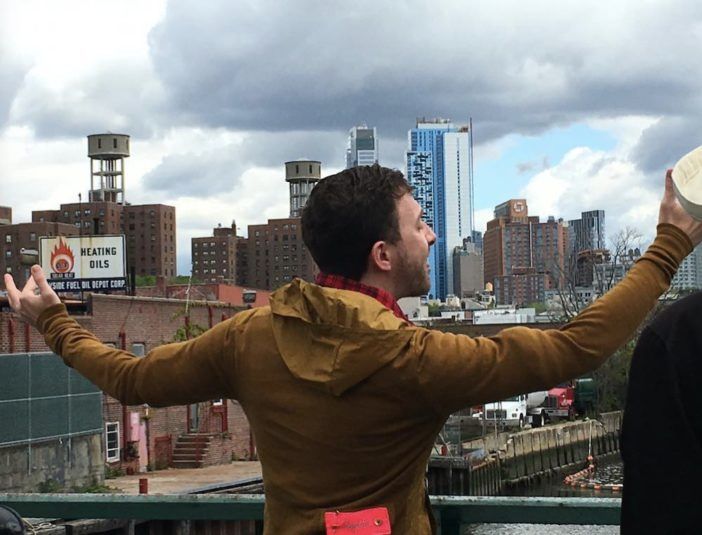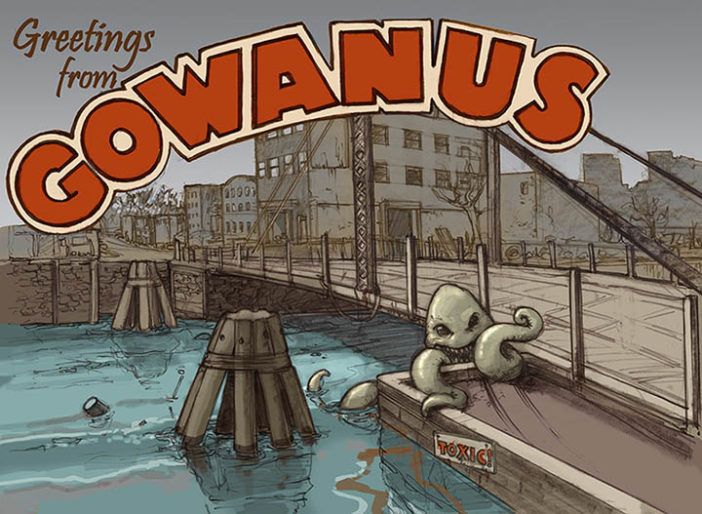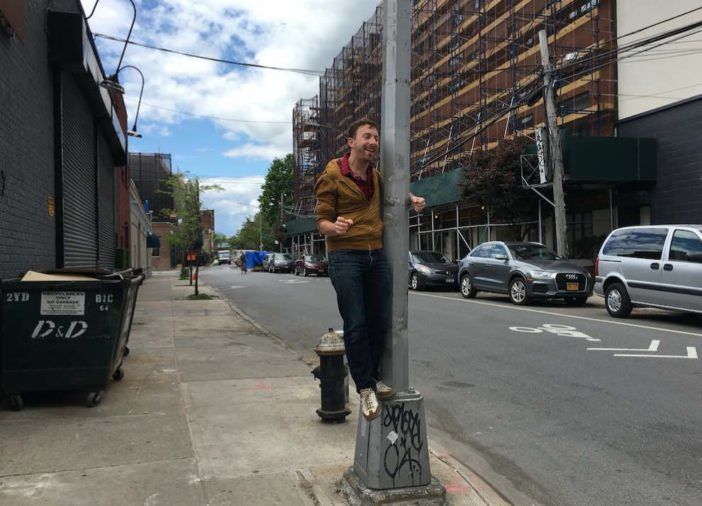It’s Joseph Alexiou’s Gowanus Canal, We Just Swim In It


“It’s a little pungent today.”
On a recent Sunday, author, journalist, and historian Joseph Alexiou was leading a group on a walking tour focused on the history of the Gowanus Canal and the surrounding neighborhood.
He paused for a moment while everyone gathered to get in earshot of his voice. He paused once again as a few cars rumbled over the Union Street Bridge. “It’s a little pungent out today,” Alexiou said, surveying the olfactorial realities rising from the curious canal. 30 other nostrils seemed to be in agreement.
But for Alexiou, the smell of the Gowanus Canal is a fascinating and layered story, worthy of intense historical study.
Not your “Run-of-the-Freeks-Mill” tour guide.
Alexiou may be a licensed tour guide, however he was giving anything but your run-of-the-Freeks-Mill tour of Brooklyn that afternoon. Alexiou’s book Gowanus: Brooklyn’s Curious Canal (G:BCC) was published in October 2015. The book is a must-read for curious locals, historians, environmentalists, and just about anyone else who has happened across this strange land.
But our tour guide’s writing isn’t limited to our neighborhood’s “lavender lake”; should you fancy a visit to Paris, you can read his Paris for Dummies and think about sipping some Beaujolais as opposed to a poonami.
“Part of the reason I moved to this neighborhood was because rent was cheap,” says Alexiou, who lived a few blocks away from the canal between 2006 and 2011. During an afternoon talk at Gorilla Coffee on 5th Avenue, he explained that his interest in the canal doesn’t come as much of a surprise. “I’ve been fascinated with urban space for a long time.”

“The Gowanus found me.”
Alexiou certainly isn’t the first neighbor to become enthralled with the history of the Gowanus. “I wanted to write a book at some point. The Gowanus found me,” he says.
And readers will find that his mix of deeply-researched history combined with accessibility for the “sludge newbie” hits the sweet spot of “pop culture history.”
For those of you familiar with Robert Sullivan’s Rats: Observations on the History and Habitat of the City’s Most Unwanted Inhabitants, Ladies and Gentlemen, The Bronx Is Burning by Jonathan Mahler, or Will Hermes’ Love Goes to Buildings on Fire: Five Years in New York That Changed Music Forever, Alexiou’s G:BCC provides that “deep dive” into a subject with enjoyable clarity.

“…oysters larger than your hand.”
To understand the history of the Gowanus is to understand oysters.
Alexiou writes about Dutch missionary Jasper Danckaerts, who was a member of the Labadists, “a now-defunct Protestant sect that promoted, among other things, early-Christian-style communal living.” It was the missionary’s Diary of Jasper Danckaerts which serves as a chronicle of his travels between 1679-80 throughout the East Coast which provides us with tremendous insight during his time in Gowanus.
Danckaerts was struck by the oysters they roasted, which were pulled from what was then a tidal estuary teeming with fish and other wildlife. “They are large and full,” wrote Danckaerts, “some of them not less than a foot long, and they grow sometimes ten, twelve, and sixteen together, and are then like a piece of rock.”

“All New York stories are real estate stories.”
At one point during the tour, Alexiou climbs onto the rail of the Union Street bridge and pulls a seed pod from the tree. He explains that crates would be transported up the Gowanus filled with these seed pods originating from Southeast Asia. They were used for the packing of porcelain, and the pods were subsequently discarded into the canal.
And now, this tree — a vestige of industrialization over centuries — remains from a different time. “There’s a cyborg connection between the natural world and the urban world,” says Alexiou, who spends much of the book documenting the establishment of mills, a trading post, and later, real estate developers.
One of the most intriguing stories is that of real estate developer Edwin Litchfield (1815-1885), who was also a lawyer and railroad magnate.
Alexiou writes:
“Beginning in 1853, he graded and paved several city-mapped streets on his empty meadows using entirely his own money. Flushed with cash, the railroad mogul was spending with great abandon on roads what others did on stock trading or luxury goods. The first and most important was Third Street: up to that point there were no streets running the length of the Gowanus meadows that would connect his newly developing neighborhood to the rest of South Brooklyn.”
A mantra of Alexiou’s is “all New York stories are real estate stories.” Not only does he point to examples from the 18th and 19th centuries, he brings up some of the most immediate projects that are happening in the neighborhood.

The Lightstone Project at 363-365 Bond Street serves as perhaps the most stunning of the real estate stories in the neighborhood. These new luxury condos (Alexiou points out they will consist of 40% affordable housing) have been built on the canal where the process of dredging will take place in the future.
Alexiou says that the canal has 10 feet on average of toxic waste along the bottom of the entire 1.8 miles, which adds up to an estimated 300-400 million gallons of raw sewage.
And the process of dredging the Superfund site has been one of heated debate. While undecided at this point, certain factors may lead to having the toxic sludge removed by specially sealed trucks and taken through the streets — passing under the bedroom windows of those who are living beside the canal.

“Waterfronts were built for the public.”
Alexiou leads the tour group along Bond Street to the intersection of President Street where he points out a “PRIVATE PROPERTY: No Trespassing” sign leading towards the waterfront. “It’s a false sign,” he says, proving his point by walking past the gate. “We are legally allowed to enter here. Waterfronts were built for the public,” he says.
For Alexiou, this is a vital point — a trope that is imbedded in G:BCC. “It’s not simply just about owning the land,” he says. “It’s about the importance of committing to use it for something good.”

“The Brooklyn Toughs of 3rd Avenue.”
As we round the corner from Union Street to 3rd Avenue, Alexiou points out the striking difference between the 3rd Avenue of today and that of the early 20th century. “The representative tough New Yorker that you saw in films,” were the types of people that walked down this street.
Alexiou gestures to CubeSmart Storage (338 3rd Avenue) which he says used to be the The Jewish Press Building. He looks toward 540 President Street which used to house the now-shuttered costumes and props mecca Film Biz Recycling.
3rd and 3rd.
Our tour ends right across the street from the Gowanus Whole Foods, close to the intersection of 3rd Avenue and 3rd Street. And while the irony isn’t lost as we view the grocery store across the street, Alexiou doesn’t betray despondence. On the contrary, he seems hungry for more information and opportunities to explore.
He projected that same energy over coffee. “I think my own youthful curiosity was a boon to this situation.”
However that doesn’t take away from Alexiou’s passion about the neighborhood, and the importance of cleaning up the canal.
“Every generation gets a chance to try. Now it’s our turn.”
Visit Joseph Alexiou’s website for future tours and other news.



